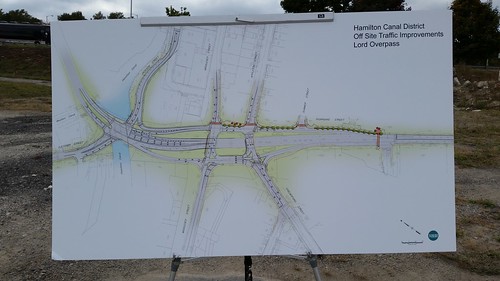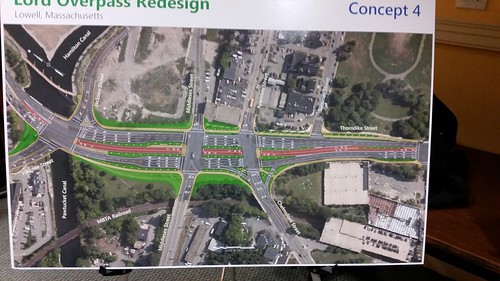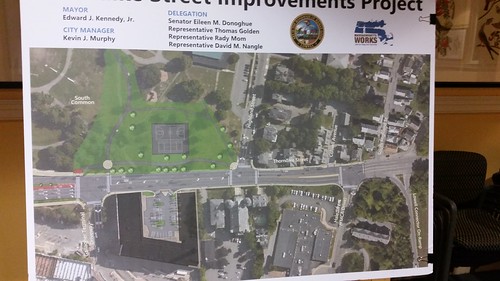Lord Overpass update
Members of Lowell’s Division of Planning and Development provided an update last evening on the remake of the Lord Overpass. Held at the Pollard Memorial Library’s public meeting room, the event drew about three dozen people, including Mayor Ed Kennedy, Councilors Bill Samaras, John Leahy and Rodney Elliott, and Councilors-elect Karen Cirillo and Dave Conway.
By way of background, this project has been driven by a number of factors, two in particular. One is that the early-1960s Lord Overpass, which we know as a rotary elevated above Thorndike Street, is really just two bridges: one connecting Chelmsford to Appleton streets; the other connecting two sections of Middlesex Street. Both of those bridges have seriously deteriorated through the years and are in need of replacement.

Original design showing existing Lord Overpass
The second factor is the now under construction Lowell Judicial Center. Scheduled to open in the summer of 2019, the Judicial Center is expected to draw 1400 people per day, many of whom will be coming from the Lowell Connector. The 2014 sketch in the photo above was created to show how vehicles coming from the Connector would get to the Judicial Center. The existing Lord Overpass is at the center of the photo and the road in the upper left corner, heading towards the top of the map, is the extension of Jackson Street. Everyone agreed that vehicles coming from the Connector’s Thorndike Street exit would proceed inbound on Thorndike Street and then turn right into Jackson Street Extension and the Judicial Center.
The problem with that route is that when it came time for the subject vehicle to turn right onto Jackson Street Extension, it would be crossing in front of the down ramp from the Lord Overpass, a traffic maneuver both dangerous and unfeasible. So to safely turn into Jackson Street, a vehicle coming from the Connector would have to proceed up the ramp onto the Lord Overpass (the ramp that begins right after the Gallagher Terminal entrance), pass through the lights at Appleton Street and at Middlesex Street, start down the ramp from the Overpass to Thorndike Street inbound, but then turn right onto Jackson Street.
Can you imagine someone new to Lowell attempting that maneuver during peak traffic times? I can’t, and neither could the city’s traffic engineers. So that, more than anything else, convinced planners that filling in the Lord Overpass and making it a traditional, surface level intersection, was the best solution.

Current design showing filled-in Lord Overpass
That has brought us to “Concept 4” which is shown in the photo above. This plan was introduced to the city council and to the public last fall, to excellent reviews (the council endorsed it by a 9 to 0 vote and the hundred or so people at a public meeting burst into spontaneous applause at its unveiling).
The plan hasn’t changed much since last fall. Its main features are two through lanes on Thorndike Street, both inbound and outbound, plus a variety of left and right turn lanes. Bisecting all of those Thorndike Street lanes will be parallel intersections with Middlesex and Chelmsford/Appleton. Design for this phase of the project is ongoing with work expected to commence as soon as the end of next summer with an expected completion date in 2020.

The Gallagher Terminal to Lowell Connector stretch
The stretch of Thorndike Street from the Lowell Connector to the Gallagher Terminal is another phase of this project that will be underway soon – bids are already out with construction expected to begin early this spring. This phase, shown above, is mostly intended to keep outbound traffic from backing up into the new Lord Overpass intersection.
The vast majority of the cars heading outbound on Thorndike Street take the on ramp to the Lowell Connector. This forces all of those cars into the right hand lane of Thorndike Street, creating a great bottleneck. The key to this phase is widening the onramp to the Lowell Connector at Thorndike Street from its current one lane to two. That way vehicles in both lanes of Thorndike Street outbound will be able to turn right onto the Lowell Connector onramp. To accommodate the extra lane merging onto the Connector at the top of the ramp, the start of the Connector at Gorham Street will only be one lane rather than the current two. The Connector will still widen to three lanes as it passes over Thorndike Street, but two lanes rather than just the current one will be added at that point.
Other parts of this phase include a dedicated left turn lane onto Highland Street from Thorndike which will get vehicles waiting to make that turn out of the way of the outbound traffic on Thorndike Street, and vehicles coming from Highland Street will be able to turn both left and right onto Thorndike (they can only turn right now).
This is an extremely complex project. Its success is largely dependent on the ability to synchronize the traffic lights so that the mass of vehicles leaving the downtown and the Hamilton Canal District at the end of the workday don’t create gridlock at this new intersection. Last night it became clear to accomplish that goal, some trade-offs must be made.
The biggest of those trade-offs was the absence of dedicated, protected bike lanes. There will be a five-foot shoulder alongside the travel lanes that will be available for bicyclists, and the sidewalks will be extra wide and called “multi-use paths” to accommodate both pedestrians and bicyclists, but the bicycling proponents in attendance expressed their overall disappointment with the concept, explaining that mixing bikes and pedestrians create dangers for both and that the five-foot wide shoulder, while acceptable for hard-core bike riders who will ride in any conditions, will not provide the level of comfort and safety needed to get casual bikers on the road too.
City Planners responded that recent changes in Mass Dept of Transportation regulations about dedicated bike lanes make them extremely complex to construct and that injecting them into this already complex design would make the overall concept unfeasible. The planners did promise to revisit the details of how bikes are expected to traverse this new intersection and find ways to make it safer and more inviting.
Two other areas of concern briefly expressed were the overall width that pedestrians will have to cross – in some cases it will be up to six lanes of traffic. There will be “walk” lights that are timed to the pace of an elderly person walking across, but it is still a long distance. The other concern was about the likelihood that the design and its synchronized lights would be able to accommodate all of the traffic that is expected to be drawn to the Hamilton Canal District.
One thing that was very helpful, was a computer generated video clip that depicts the drive from downtown to the Gallagher Terminal on this new route. The video made it much easier to understand the coming changes, and gives you a boost of confidence that they will work as planned. Planners hope to make that video available on the city’s website in the coming days. I’ll be sure to link to it once it is available.
Overall, I was pleased with the information shared last night. Hopefully there will be room for some tweaks to make the design better for bikers and walkers, but to me, the city is moving in the right direction with this project.
From the pedestrian perspective, this design has some great features. The new Thorndike/Jackson/Fletcher Street intersection will be a four-way traditional intersection with crosswalks and signals on all four sides. The dedicated bus lane in the middle – a great use of the available width – provides for pedestrian refuges for people walking from Middlesex and Chelmsford Streets into the HCD.
The existing Lord Overpass is a highway project that divided two of Lowell’s neighborhoods from each other. This new design is an urban roadway that will effectively connect them. This is going to be a great improvement.
I look forward to the video as I find it hard to make updates in dark.
This plan is absurd. The people that burst into spontaneous applause months ago did so because they though it would help knit back together the Highlands and The Downtown – making it easier to walk and bike thus reducing congestion.
Extra wide sidewalks will make no difference. Would you walk along a 6-lane highway with cars whizzing by at 50 mph or idling in bumper-to-bumper traffic?
This plan will further isolate Sal’s new Thorndike Exchange and Gallagher Terminal from Downtown.
“City Planners responded that recent changes in Mass Dept of Transportation regulations about dedicated bike lanes make them extremely complex to construct and that injecting them into this already complex design would make the overall concept unfeasible.”
This is laughable. All it takes is some plastic flex posts to give people a buffer and sense of protection. Just reduce the car lane widths to gain space for this.
This silver line is the mistakes made in the past and today can be fixed in the future now that the overpass will be filled in.
“City Planners responded that recent changes in Mass Dept of Transportation regulations about dedicated bike lanes make them extremely complex to construct and that injecting them into this already complex design would make the overall concept unfeasible.”
Did anyone bring up getting a quick little feasibility report from the designers?
Apparently there’s an easier solutions to have a separated bike lane. If there’s 5 feet of unused shoulder the street is too big.
Shift the curb in 5 feet and put the bike lane on top next to the pedestrian sidewalk.
Additionally this will put a buffer between the walkers and cars, making for a safer and better experience for all.
https://www.aarp.org/livable-communities/getting-around/info-2016/why-bicycling-infrastructure-is-good-for-people-who-dont-ride-bikes.html
Basic bicycle safety calls for cyclists to ride in a dedicated bicycle lane or on the street, traveling in the same direction as automobiles. Never, never, never do you ride your bicycle on the sidewalk. Mixing bicycles and pedestrians is a recipe for frustration at best, danger at worst. Here we go again, not coming up with a “complete streets” design and, once again, the car is king. I could not be more disappointed.
One lane of the Connector from Gorham Street is fine. I have never seen two lanes of traffic use that entrance. Much better with the two lanes coming from Thorndike.
I lack faith in shared bike/pedestrian paved lanes in a context like this. This isn’t a rear alley or lane that leads to parking behind the sides and rear of houses; this is a major transportation corridor. It’s wide-open, and cyclists will ride it as such. And then pedestrians too?
1. How much will it cost the city to have IBM’s Watson synchronize the traffic lights? And even that super-computer might fail, especially on the outbound traffic! With the three current traffic lights (Gallagher Terminal, Highland Avenue, and YMCA Drive), the Thorndike Street backup can stretch all the way back to the on-ramp to Middlesex Street outbound, and that can be any time of the day, not just rush hours.
Now add three more sets of lights at Jackson, Middlesex, and Appleton Streets to accommodate the east/west cross traffic. Dutton Street will back up to Market Street, and Fletcher Street at least to Market Basket. Plus, if you allow southbound Fletcher Street drivers to once more take a left onto Dutton Street, you would further complicate an already impossible traffic scenario caused by this overpass elimination.
2. As to the “complete streets” fallacy, most bicycle riders (hard-core and casual) currently ride the sidewalks. If they use the street (with or without dedicated bike lanes), they totally ignore traffic lights. How many have you seen actually stopped at a red light?
3. The new design will reintroduce the winter safety issues inherent in the severe north/south grade that will result from filling in Thorndike Street. I’m old enough to remember the winter nightmares on that hill before it was cut down for the two-level Lord Overpass.
4. God, it’s bad enough you’ll never build a permanent, four-lane Rourke bridge to let me into Lowell, now you’re going to fill in the Lord overpass to prevent me from getting out of Lowell. You’ll excuse me if I don’t applaud as others have done.
While I agree that synchronization of lights is an exercise in futility Leon is exactly the type person we don’t want to be catering to in making infrastructure decisions in Lowell. A city that is easy to drive in and out of is not one worth living in.
What the Leon’s of the world don’t get about good protected bike networks is that they reduce car traffic and are better for businesses because bikers are more apt to stop and shop than someone worried about getting across 4-lane bridges to the hinterlands.
I’m reminded of Yelp reviewers frequent only complaint of urban restaurants being the parking, not realizing that the human scale built environment, and corresponding lack of parking, is its raison detre for locating there.
So folks like me who live in Dracut don’t matter, Brian? I certainly spend my fair share of time and money in Lowell and I take the Connector most of the time when I need to go farther away.
When I lived in Somerville, bike commuters were noticeably absent in Winter Hill because of the terrain, though they were prevalent pretty much everywhere else in the city. Leon’s point about the grade and winter weather is very valid.
Dracut is nice, but sometimes I need my city fix, so I head over to downtown Lowell. :)
Meredith,
I’m glad you like Lowell but making downtown easier to drive thru isn’t good for the downtown. The shops that are chronically vacant are on streets dominated by vehicular throughput – such as Dutton, Bridge, and Central St up by the Kettle. These streets could be enlivened with protected bike lanes to the neighborhoods and better walkability.
Here’s a good article explaining safe bike infrastructure from a Winter Hill residents’ perspective.
https://digboston.com/the-somerville-lane-and-the-long-road-to-a-bikeable-beacon-street/
It’s crucial that livability for Lowell residents comes before those passing through. I think it will ultimately give you more reasons to visit.